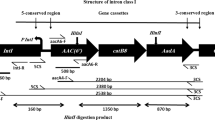Abstract
The aim of this study was to determine the presence of bla CTX-M-2 in our A. baumannii population and their putative role as an alternative mechanism of resistance to third-generation cephalosporins in this species. The bla CTX-M-2 gene is widespread among the Enterobacteriaceae isolates from our country; however, it was not found in 76 isolates A. baumannii non-epidemiologically related clinical isolates resistant to third-generation cephalosporins isolated since 1982 in hospitals from Buenos Aires City. A plasmid isolated from Proteus mirabilis that possesses the complex class 1 integron In35::ISCR1::bla CTX-M-2 was used to transform the natural competent A. baumannii clinical strain A118. PCR, plasmid extraction, DNA restriction, and susceptibility test confirmed that A118 could gain and maintain the plasmid possessing In35::ISCR1::bla CTX-M-2, the genetic platform where the bla CTX-M-2 gene is dispersing in Argentina.
Similar content being viewed by others
References
Arduino SM, Catalano M, Orman BE, Roy PH, Centrón D (2003) Molecular epidemiology of orf513-bearing class 1 integrons in multiresistant clinical isolates from Argentinean hospitals. Antimicrob Agents Chemother 47:3945–3949
Celenza G, Pellegrini C, Caccamo M, Segatore B, Amicosante G, Perilli M (2006) Spread of bla(CTX-M-type) and bla(PER-2) beta-lactamase genes in clinical isolates from Bolivian hospitals. J Antimicrob Chemother 57:975–978
Clinical and Laboratory Standards Institute (CLSI) (2006) Methods for dilution antimicrobial susceptibility test for bacteria that grow aerobically. Approved standard M7–A7. Clinical and Laboratory Standards Institute, Wayne
Di Conza J, Ayala JA, Power P, Mollerach M, Gutkind G (2002) Novel class 1 integron (InS21) carrying blaCTX-M-2 in Salmonella enterica serovar infantis. Antimicrob Agents Chemother 46:2257–2261
Garnacho-Montero J, Amaya-Villar R (2010) Multiresistant Acinetobacter baumannii infections: epidemiology and management. Curr Opin Infect Dis 23:332–339
Gordon NC, Wareham DW (2010) Multidrug-resistant Acinetobacter baumannii: mechanisms of virulence and resistance. Int J Antimicrob Agents 35:219–226
Morgan DJ, Liang SY, Smith CL, Johnson JK, Harris AD, Furuno JP, Thom KA, Snyder GM, Day HR, Perencevich EN (2010) Frequent multidrug-resistant Acinetobacter baumannii contamination of gloves, gowns, and hands of healthcare workers. Infect Control Hosp Epidemiol 31:716–721
Nagano N, Nagano Y, Cordevant C, Shibata N, Arakawa Y (2004) Nosocomial transmission of CTX-M-2 beta-lactamase-producing Acinetobacter baumannii in a neurosurgery ward. J Clin Microbiol 42:3978–3984
Orman BE, Pineiro SA, Arduino S, Galas M, Melano R, Caffer MI, Sordelli DO, Centrón D (2002) Evolution of multiresistance in nontyphoid salmonella serovars from 1984 to 1998 in Argentina. Antimicrob Agents Chemother 46:3963–3970
Perez F, Hujer AM, Hujer KM, Decker BK, Rather PN, Bonomo RA (2007) Global challenge of multidrug-resistant Acinetobacter baumannii. Antimicrob Agents Chemother 51:3471–3484
Predari SKS, Gutierrez MA, De Paulis A, Guelfand L, García DC (1991) In vitro activity of 16 antibiotics and sulbactam against Acinetobacter calcoaceticus phenotype A1. J Chemother 4S:20–25
Quiroga MP, Andres P, Petroni A, Soler Bistue AJ, Guerriero L, Vargas LJ, Zorreguieta A, Tokumoto M, Quiroga C, Tolmasky ME, Galas M, Centrón D (2007) Complex class 1 integrons with diverse variable regions, including aac(6′)-Ib-cr, and a novel allele, qnrB10, associated with ISCR1 in clinical enterobacterial isolates from Argentina. Antimicrob Agents Chemother 51:4466–4470
Ramírez MS, Don M, Merkier AK, Bistue AJ, Zorreguieta A, Centrón D, Tolmasky ME (2010) Naturally competent Acinetobacter baumannii clinical isolate as a convenient model for genetic studies. J Clin Microbiol 48:1488–1490
Roy Chowdhury P, Ingold A, Vanegas N, Martinez E, Merlino J, Merkier AK, Castro M, Gonzalez Rocha G, Borthagaray G, Centrón D, Bello Toledo H, Marquez CM, Stokes HW (2011) Dissemination of multiple drug resistance genes by class 1 integrons in Klebsiella pneumoniae isolates from four countries: a comparative study. Antimicrob Agents Chemother 55:3140–3149
Tolmasky ME, Colloms S, Blakely G, Sherratt DJ (2000) Stability by multimer resolution of pJHCMW1 is due to the Tn1331 resolvase and not to the Escherichia coli Xer system. Microbiology 146(Pt 3):581–589
Acknowledgments
M.S.R and D.C. are members of the Carrera del Investigador Científico, C.O.N.I.C.E.T., Argentina. M.P.Q. is a recipient of a C.O.N.I.C.E.T. fellowship. This study was supported by grant BID/OC 1723 ANPCyT 0690 and PICT 0354 from the Agencia Nacional de Promoción de Ciencia y Técnica to D.C. and M.S.R., respectively, Buenos Aires, Argentina.
Author information
Authors and Affiliations
Corresponding author
Rights and permissions
About this article
Cite this article
Ramírez, M.S., Merkier, A.K., Quiroga, M.P. et al. Acinetobacter baumannii is Able to Gain and Maintain a Plasmid Harbouring In35 Found in Enterobacteriaceae Isolates From Argentina. Curr Microbiol 64, 211–213 (2012). https://doi.org/10.1007/s00284-011-0052-9
Received:
Accepted:
Published:
Issue Date:
DOI: https://doi.org/10.1007/s00284-011-0052-9




